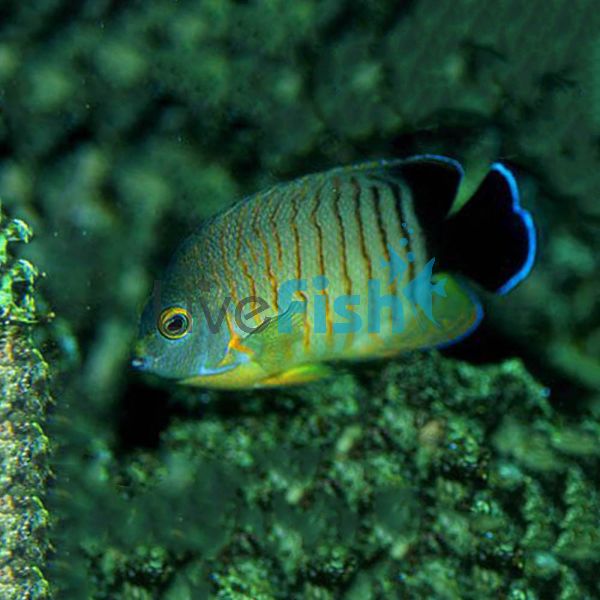Orange-Lined Angelfish - Medium
The Orange-Lined Angelfish has orange to reddish vertical lines down its body. It has orange rings around its eyes and its body is light green to gray in color and its tail is black-edged with blue. These fish make a great member of your clean-up crew, eating several algae species as well as detritus.
Orange Lined Angelfish
The Orange-Lined Angelfish is one of the hardiest of the Dwarf Angelfish. It is also one of the least aggressive which makes it a good choice for your first Angelfish.
These fish make a great member of your clean-up crew, eating several algae species as well as detritus.
They will grow up to a maximum of 15cm (6 inches) and like to
Tank Recommendations for Orange Lined Angelfish
The smallest tank size required to keep this angelfish is 208 liters. It prefers a longer tank to a deeper one and will become quite territorial over its algae cultivations.
You can keep these fish in a fish-only aquarium, but it is not considered reef safe as it may nip at large polyps stony corals, soft corals, zoanthids, and clam mantles.
They may be fine for years and then decide that they fancy eating a bit of the coral. With this in mind, it’s best to stick to either a fish-only or live rock set up with plenty of places for them to hide.
The tank should be have been up and running for at least 6 months to allow enough algae growth on the live rock before you add the Angelfish.
If you want to add more different species of dwarf Angels then allow an extra 95-114 liters per extra dwarf angel individual.
Suitable Tank Buddies
Even though it’s not particularly aggressive like most dwarf angels it’s not a good idea to keep many specimens of the same species together as they will fight.
In larger aquariums, these angelfish mix well with other dwarf angels. This is providing they are different in shape and colouration so they do not get mistaken for their own kind.
Usually Compatible
The Orange-Lined Angelfish mixes well with Anthias, Gobies, Dartfish, Fairy Wrasses, Clownfish, Dwarf Angelfish, Damselfish, Tangs, Large Angelfish, and Large Wrasses. They are also fine with Copepods, Amphipods, Mini Brittle Stars, and soft corals.
Sometime Compatible
Be careful when planning to keep these fish with Lionfish, Groupers, as if the angelfish is small enough to fit in the mouths of predators then they may become lunch.
Similarly, small shrimp may also be at risk of being eaten by the Angelfish, but larger shrimp should be fine.
You can keep a mated pair of Orange-Lined Angelfish together, but unmated individuals are likely to fight unless they are in a large tank.
Rarely Compatible
Don’t keep slow swimmers such as Seahorses, Pipefish, and Mandarins with these Angelfish as they will struggle to compete for food. They will not live together for long as the slow swimmers will eventually starve. Larger predators like Eels and Sharks aren’t good to mix with these Angelfish either as they will see them as a food source.
Feeding Your Orange Lined Angelfish
These Angelfish are omnivores and in the wild, it feeds on benthic algae, benthic weeds, and hard coral polyps.
In the aquarium, it will eat algae growing on live rock, so ensure there is plenty which you can supplement with pellet and flake foods.
They will also eat live foods like mysis and brine shrimps and take frozen prepared foods for sponge and algae eaters.
Feed them at least twice a day in a tank with plenty of natural food and more so in bare tanks. Feed juveniles three to four times a day.
| Scientific Name | Centropyge Eibli |
|---|---|
| Care Level | Moderate |
| Common Names | Orange Lined Angelfish, Eibli's Angelfish, Blacktail Angelfish and Red Stripe Angelfish |
| Diet | Omnivore |
| Fish Family | Pomacanthidae |
| Lifespan (years) | 6 |
| Max. Length (cm) | 15 |
| Min. Tank Volume (l) | 208 |
| Origin | Indo-Pacific, Sri Lanka, Fiji, Australia, Indian Ocean |
| Reef Safe | No |
| Sociability | Semi-aggressive |
| Venomous | No |
| Water Conditions | 22 -28°C, dKH 8-12, pH 8.0-8.4, sg 1.023-1.025 |




